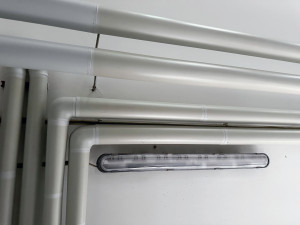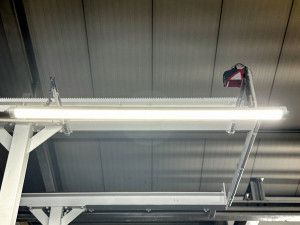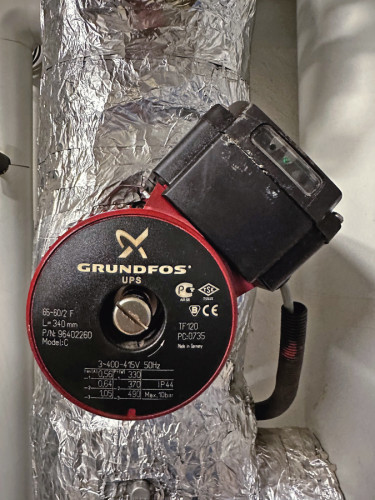It's frightening to see that there really are still companies that don't use LED lighting and electronic heating pumps. This is a must before any investment. The necessity of insulating heating, water or cooling pipes, on the other hand, is debatable. Insulation does not account for the majority of energy savings, but had to be installed at Strähle and MVB because of the long distances.
LED lamps
 Fig. 1: Insulated heating with LED lightHaveyou ever counted the fluorescent tubes in your company? Savings through LED lighting really should not be underestimated, as 250 - 300 fluorescent tubes are certainly not uncommon in a medium-sized company. A fluorescent tube has an energy requirement of 58 watts. If you replace these, you not only save electricity, you also have much better lighting and only need half the amount of light sources (Fig. 1).
Fig. 1: Insulated heating with LED lightHaveyou ever counted the fluorescent tubes in your company? Savings through LED lighting really should not be underestimated, as 250 - 300 fluorescent tubes are certainly not uncommon in a medium-sized company. A fluorescent tube has an energy requirement of 58 watts. If you replace these, you not only save electricity, you also have much better lighting and only need half the amount of light sources (Fig. 1).
300 X 58 watts = 17.4 kW
150 X 29 watts = 4.35 kW
The advantage of LED luminaires is their lower power consumption and longer service life.
LED lights are becoming cheaper - and are convincing across the board
The lower power consumption speaks in favor of LED tubes. Conventional T5 tubes with a diameter of 16 mm and a length of 150 cm have a power consumption of 58 watts including ballast. The corresponding LED counterpart with a slightly higher light intensity of 293 lux (fluorescent tube: 280 lux) only requires 29 W. The service life is also generally in favor of the LED; depending on the quality, 20,000-50,000 operating hours should be achieved. The fluorescent tube only achieves around 10,000 hours, and is also comparatively susceptible to frequent switching on and off. If the fluorescent tube is located in a passageway, there is also a risk that it will fail a little more quickly. Another problem if a fluorescent tube is switched on and off frequently: the full brightness is not available immediately after switching on. Here, too, the LED is convincing in direct comparison, because such problems do not arise. Depending on the installation location, it should also be noted that LEDs hardly convert any energy into heat due to their high energy efficiency.
Fluorescent tubes with hazardous mercury
 Fig. 2: Modern LED luminaireFroman environmental point of view, the balance for fluorescent tubes isalsorelatively poor. Although this lighting technology is quite economical, at least compared to conventional light bulbs, its energy consumption is - as already mentioned - still significantly higher than that of LEDs. Even more serious, however, is the fact that fluorescent tubes do not work without mercury vapor.
Fig. 2: Modern LED luminaireFroman environmental point of view, the balance for fluorescent tubes isalsorelatively poor. Although this lighting technology is quite economical, at least compared to conventional light bulbs, its energy consumption is - as already mentioned - still significantly higher than that of LEDs. Even more serious, however, is the fact that fluorescent tubes do not work without mercury vapor.
For this reason, it is problematic if a fluorescent tube breaks - the mercury vaporizes at room temperature and is highly toxic. For this reason, you should also ensure that the fluorescent tube is disposed of properly.
Match the light color to the intended use
If you are considering switching to LEDs, you should also bear in mind that LEDs are available in different light colors. This allows you to adapt the lighting to the intended use. In the office, for example, it may be advisable to opt for a "cold white" LED with a color temperature of around 10,000 K. The advantage of this is that it is easier to concentrate on work even with artificial lighting. In contrast, the "warm white" with a light color of 2,700 K that is typically offered in stores has a cozier effect. Depending on the room, such an effect may be desirable, but in the evening such lighting also ensures that we release more of the "sleep hormone" melatonin - and gradually become tired and unable to concentrate.
Conclusion
The LED tube is convincing across the board.
Overall, the comparison seems to be clearly in favor of LED tubes. The advantage of fluorescent tubes is limited to the lower purchase price. In view of the falling costs of LED fluorescent tubes, however, it hardly seems advisable to rely on the outdated technology for this reason alone. In commercial applications in particular, long operating times ensure that the decision in favor of LEDs is quickly amortized. However, if the existing fluorescent tubes are still working, replacing them is hardly worthwhile for reasons of savings alone. In the event of a defect, however, the much more efficient LED tube should be used - for the sake of the environment and your wallet. The icing on the cake would be controllable strip lighting with daylight-dependent dimming or switching off every second lamp (Fig. 2).
Controllable pumps
The old magnetically coupled heating pumps with an output of up to 700 watts are still around.
700 Watt x 16 h x 22 AT x 50 KW x 0.23 cent /Kwh electricity = 2833 Euro. How many pumps do you have in your boiler room?
A new energy-efficient pump pays for itself after just one year. You should urgently switch to the latest generation of electronically controlled pumps.
The latest generation of pumps pays for itself after 1 year
It is possible to reduce from 700 watts to 150-200 watts. These pumps work with differential pressure control, i.e. the difference between the pressure side and the suction side of the pump is measured and then the pump output is regulated so that this differential pressure is virtually equalized. The new technology detects the flow rate and temperature and automatically adjusts to the required output (Fig. 3 and 4).
Photos: Strähle Galvanik / MVB Metallveredlung




